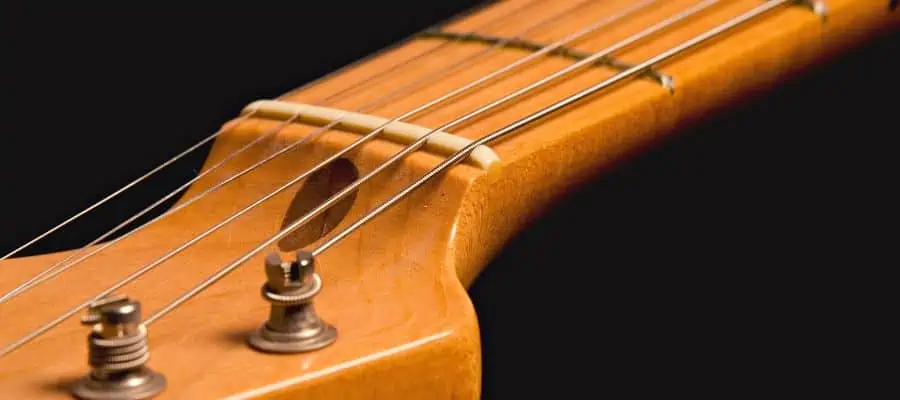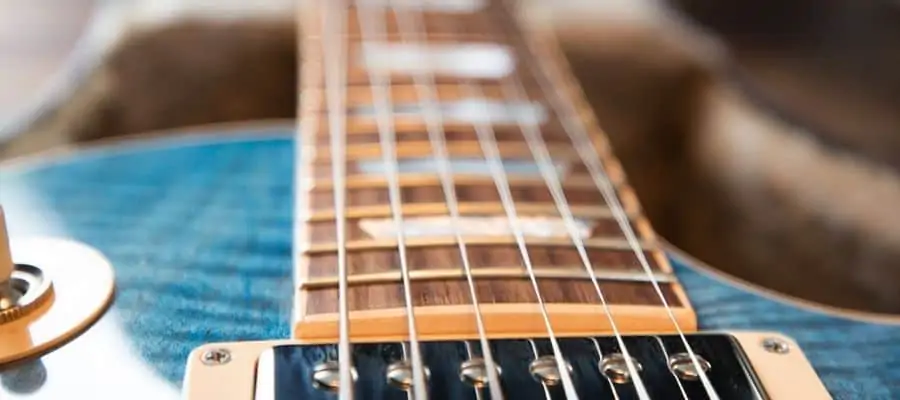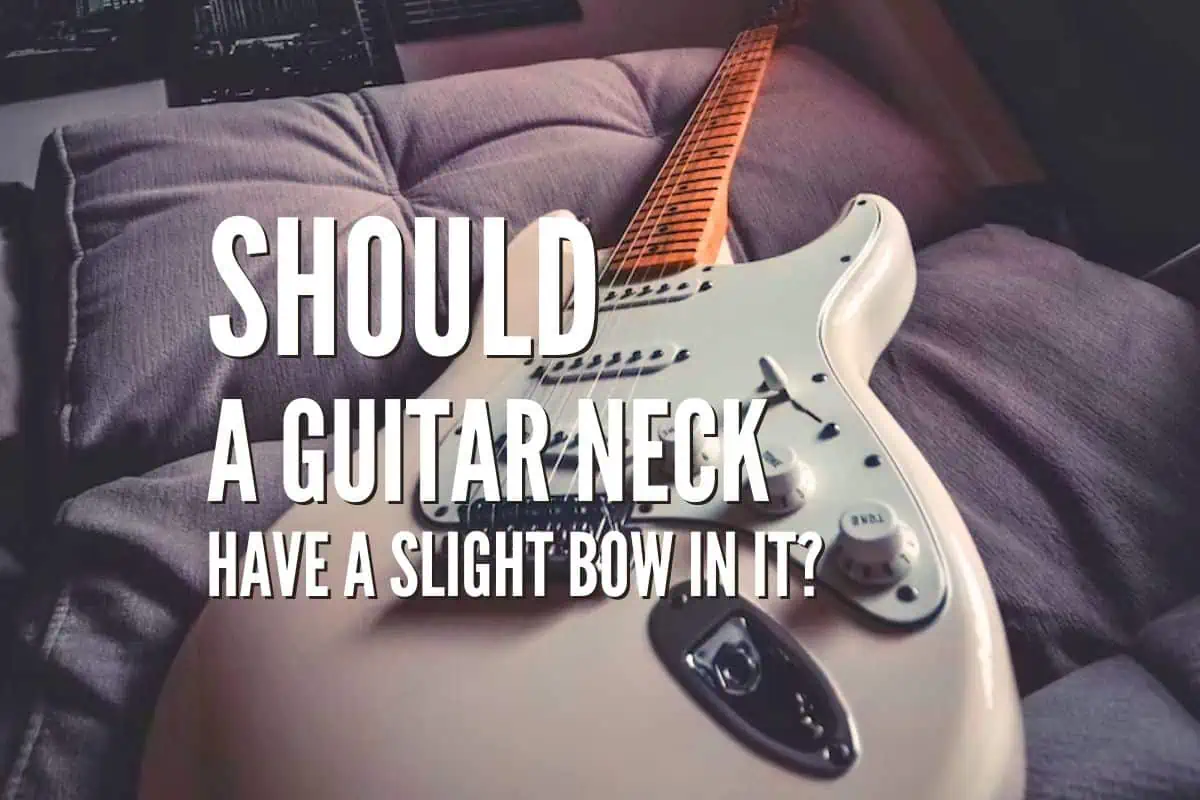If you take a closer look at the neck of your guitar, you might notice that it has a slight bow. This may seem unusual to you as you may have assumed that the neck of an average guitar is perfectly straight. However, the question remains: Is this bow normal, or is it an issue that needs to be addressed?
A guitar’s neck should have a slight curve or bow, also known as neck relief. This slight curvature is necessary to ensure the strings remain far from the fretboard. Neck relief is significant because it prevents any buzzing sounds and improves the guitar’s overall playability. You can adjust the neck relief by using the truss rod.
If you want to know more, stick around! I’ll explain why most guitar necks should have a slight bow in them and show you what neck relief is. Additionally, I’ll give you some tips on determining if a guitar neck is too bent forward and what to do in that particular case.
Why Your Guitar Neck Should Not Be Perfectly Straight

Many guitarists unfamiliar with guitars assume that their necks are entirely straight, similar to the handle of a tennis racquet. This is understandable because, at first glance, all guitar necks appear straight. However, most guitars have slightly bowed necks, even though this shape is not noticeable to most people.
It’s completely normal for guitars to have a slight bow in the neck, which is caused by the string tension. This bow is preferable, as it ensures that the sounds produced by the instrument are clear and crisp. Both manufacturers and luthiers intentionally create this bow to facilitate “neck relief.”
What Is Neck Relief?
Neck relief is the intentional slight bow created in neck guitars, which allows the strings to sit at a particular distance from the fretboard, creating optimal sound quality. Most guitars already have a certain degree of neck relief, which is enabled by adjusting a truss rod to the desired degree.
Most guitars and basses need to have neck relief to avoid buzzing issues and to allow you to press on the strings more easily. This slight curvature not only makes a significant difference in the way you play but also in the way your guitar sounds. If the neck of your guitar were utterly straight, you would deal with the weird buzzing sounds because the strings would make more contact with the fretboard.
It’s important to understand that the amount of neck relief in a guitar neck should be just right; otherwise, you’ll notice that the sound will be off. Determining the proper neck relief is a job for experienced guitarists and luthiers who can use different tools to create the perfect slight bow. If you’re unsure if your guitar has enough neck relief, you should contact an expert instead of trying to adjust the truss rod yourself.
Determining the Appropriate Level of Neck Relief on a Guitar

As I mentioned above, any guitar has optimal neck relief; any more or less relief can result in more issues. Some people may assume that as long as there’s a bow to its neck, the guitar will be easily playable and have a good, solid sound.
However, too much relief can cause the action to increase too much, so the strings stay too far away from the fretboard. This will make it more difficult for you to play the instrument.
On the other hand, being conservative with the amount of neck relief is not a solution either. If you don’t provide a certain degree of relief, you will start to hear the buzzing sound you’re trying to avoid. As a result, luthiers and musicians need to be precise when adjusting the bow in a guitar’s neck.
It’s difficult to determine the appropriate level of neck relief on a guitar because every instrument is built differently and has its own needs. Different guitar models have their own appropriate degree of neck relief, depending on the material they are made of, the shape and radius of the neck, and many other factors. Additionally, the condition of the guitar also makes a difference.
Generally, there should be a slight gap between the strings and the fretboard close to the middle of the neck, typically around the eighth fret. This gap can be anywhere between 0.008 inches(0.02 cm) and 0.02 inches (0.05 cm). The exact degree will depend on the factors mentioned above; the larger the neck radius, the smaller the degree of neck relief.
However, neck relief can also be subjective, depending on each player’s style and sound preference. For example, you need a higher action for slide guitar style, which means more neck relief. Playing lower action is more desirable for shredder style, so less neck relief will come in handy.
Professional luthiers and musicians use several different tools to help them determine and measure neck relief for each instrument. Tools like straightedges or feeler gauges are ideal for this process.
What To Do if the Guitar Neck Is Too Warped

Typically, the optimal amount of neck relief in a guitar is relatively small, so you may not be able to notice the bow on the neck unless you use tools to help you see it. However, the amount of neck relief can change as you play and adjust the tension of the strings. As a result, your guitar neck may become too warped, which can be an issue.
Before you try anything else, you can adjust the truss rods to attempt to correct the problem. Just release or remove the strings first and then experiment with the tightness of the rod to determine the best possible position. However, you may not be able to solve the problem this way.
In most cases, the best thing to do is take your guitar to a specialist who will determine the best possible way to fix the neck without damaging the instrument. Specialists typically use heat treatments to make the wood more flexible, allowing them to correct the neck relief. Additionally, they may level the fretboard or even replace it in more extreme cases.
Final Thoughts
Guitar necks look pretty straight, but they actually should have a slight bow to them to produce the right sounds without distracting effects. This slight bow is called neck relief, an essential aspect of a guitar. It avoids the buzzing effect of the sound and makes it easier for you to press on the strings.
The exact level of neck relief differs from guitar to guitar, depending on the exact model, material, and neck thickness. You should use special instruments like a straightedge and feeler gauge to measure the degree of neck relief.
If you found this article useful, you may want to save this pin below to your Guitar board.

Recent Posts
Some guitarists insist on buying an expensive amplifier with their electric guitar. They assume that this is a must for every type of guitarist out there. However, in some situations, this isn’t...
Top 50 Free Realistic Guitar VST Plugins With Sound Examples
As technology has rapidly advanced in the recent decade, computers are stealing more and more roles from physical musical instruments and accessories. Nowadays, you do not need expensive amps,...

